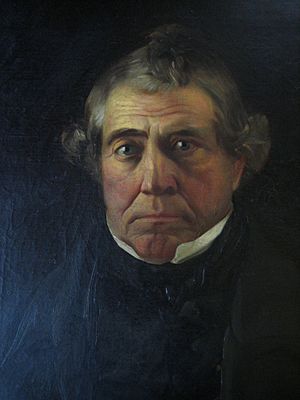Donald McKenzie (explorer) facts for kids
Quick facts for kids
Donald McKenzie
|
|
|---|---|
 |
|
| Born |
Donald McKenzie
March 2, 1783 Durness, Scotland
|
| Died | January 20, 1851 (aged 67) |
| Resting place | Mayville Cemetery, Mayville, New York |
| Occupation | fur trader, explorer, High Constable, Governor |
| Employer | North West Company, Hudson's Bay Company |
| Spouse(s) | Adelgonda Humbert Droz |
| Children | Jemima, Catherine, Roderick, Noel, Fenella, Alexander, Alice, Henry, William Peacock, Donalda, Adelgonda, Celestia, Humbertson |
Donald McKenzie (born June 16, 1783 – died January 20, 1851) was an important Scottish-Canadian explorer and fur trader. He also served as the Governor of the Red River Colony from 1821 to 1834. He played a big part in mapping and exploring the western parts of North America.
Contents
Discover Donald McKenzie's Early Life
Donald McKenzie was born in Scotland in 1783. Around the year 1800, he moved to Canada. He and his brothers became involved in the exciting world of the fur trade. This meant they bought and sold animal furs, which were very valuable at the time.
McKenzie first worked with a big company called the North West Company. In 1810, he decided to join a new company. This was the Pacific Fur Company (PFC), which was started by a wealthy businessman named John Jacob Astor.
Exploring with the Pacific Fur Company
McKenzie joined a group of PFC employees on a long journey west. They traveled from St. Louis, Missouri all the way to the Pacific Northwest. This was a very difficult trip.
The group faced many challenges in southern Idaho. They decided to split up to make their journey easier. McKenzie's small group of twelve people headed north. They eventually found the Salmon River and Clearwater River.
They continued their journey by canoe down the Snake River and Columbia River. On January 18, 1812, they were the first of their expedition to reach Fort Astoria. This fort was an important trading post on the Pacific coast.
McKenzie spent two years exploring and trading for the Pacific Fur Company. He traveled through the Willamette Valley, along the Columbia River, and in parts of eastern Washington and Idaho. In 1813, the Pacific Fur Company sold its trading posts to the North West Company. McKenzie was chosen to carry important papers back east, which he did in 1814.
Building Fort Nez Percés and Idaho Explorations
After a short break, McKenzie rejoined the North West Company in 1816. He returned to the Columbia River area. In 1818, he and another fur trader, Alexander Ross, built Fort Nez Percés. This fort was located where the Columbia River and Walla Walla River meet.
From 1818 to 1821, McKenzie and his trappers explored much of what is now southern Idaho. They made annual trips, covering large areas. Their explorations also included parts of eastern Oregon, northern Utah, and western Wyoming. Many rivers in this region still have names that came from this time.
Becoming Governor of the Red River Colony
In 1821, the North West Company joined with the Hudson's Bay Company. This was a very big merger in the fur trade world. Donald McKenzie was given an important new role. He was appointed Governor of the Red River Colony.
He left the Pacific Northwest and moved to Fort Garry. For ten years, he served as governor of this large area. It included most of what is now Manitoba, Saskatchewan, and Alberta in Canada.
Donald McKenzie's Lasting Legacy
In 1834, Donald McKenzie retired from his work. He moved to Mayville, New York, where he lived for the next two decades. Even in retirement, he was a respected figure.
Important people, like Daniel Webster and William H. Seward, visited him for advice. Both of these men later became United States Secretary of State. McKenzie shared his knowledge about where the international boundary should be set for Oregon. He may have also helped plant the idea that led to the purchase of Alaska from Russia.
Today, McKenzie Pass and the McKenzie River in Oregon are named after him. They honor his important contributions as an explorer and fur trader.
See also
 In Spanish: Donald Mackenzie para niños
In Spanish: Donald Mackenzie para niños

